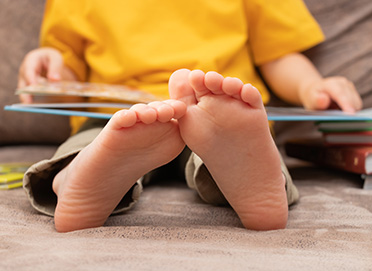Children’s feet are different from adults, as they are not yet fully formed. At 6 months of age, a babies’ foot is still mostly cartilage, in fact the last bone doesn’t start forming until children are about 3 years old. By the time we turn 18 the bones in our feet are fully matured.
Here are some tips for different life stages for foot development:
Babies
It’s recommended to keep your baby’s feet unconstrained. Playsuits with feet, socks or even natural fibre shoes can be used to keep little feet warm, but can also restrict muscle development in their legs and feet. It’s great to let your baby go barefoot as much as possible, this is how they learn to control and use their feet, through feeling.
Toddlers
Many children begin to walk between approximately 10 and 20 months of age. It is important to remember that each child is unique and will move through the development stages at their own pace. Sometimes children may walk with their feet pointed inward (in-toeing) or outward (out-toeing) and most of the time, children will outgrow these walking styles. If these walking patterns persist or if you have any concerns it is recommended, you get in touch with your podiatrist.
School Children
This is a period of rapid growth for children, where the length, shape and arch of their feet is constantly changing. This is why it’s important to keep a close eye on the size of their shoes and socks and make sure they properly accommodate their foot size (tips for choosing school shoes).
This is also the age where children tend to take up a sporting activity. If your child is complaining of pain in their feet, which limits their activity or causes them to limp, it is recommended to consult a Podiatrist.
Children’s Sport injuries
Children don’t necessarily get a sporting injury due to their body failing them. Sometimes this can be the result of a biomechanical instability somewhere, or a developmental condition called Severs Disease, Osgood-Schlatters or Legg-Calve-Perthes disease. This is why it’s so important for a qualified podiatrist to assess the injury if it’s a true sports injury or if a biomechanics structure needs to be addressed.


